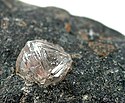Pierwiastki rodzime
| Ten artykuł od 2016-05 zawiera treści, przy których brakuje odnośników do źródeł. |
Pierwiastki rodzime – występujące w przyrodzie minerały o budowie jednorodnej, składające się z atomów tego samego pierwiastka. Pierwiastki uznaje się za tym szlachetniejsze, im mniejszą wykazują skłonność do tworzenia związków chemicznych (aktywność chemiczną). Im pierwiastek szlachetniejszy, a więc bierniejszy chemicznie, tym większe jest prawdopodobieństwo, że występuje w stanie czystym. Od tej reguły są jednak wyjątki, gdyż węgiel czy siarka, które są stosunkowo reaktywne, również występują w stanie wolnym w skorupie ziemskiej. W postaci rodzimej występuje w przyrodzie tylko 30 pierwiastków. Pierwiastki rodzime mają znikomy udział w składzie skorupy ziemskiej.
Metale rodzime
Rodzime metale szlachetne zwane są samorodkami, rodzimkami lub nuggetami[1]. Przykłady to miedź rodzima, złoto rodzime, platyna rodzima lub srebro rodzime. Z powodu dużej gęstości koncentrują się w skałach osadowych.
Niemetale rodzime
Wśród niemetali w postaci rodzimej występują np. siarka rodzima lub węgiel – jako grafit lub diament. Rodzimym półmetalem jest np. bizmut rodzimy. Nagromadzenia niemetali i półmetali rodzimych powstać mogą np. za sprawą rozkładu pierwotnych rud w czapie żelaznej. Jako produkt wyziewów wulkanicznych w fumarolach odkłada się siarka.
Przypisy
- ↑ samorodek, [w:] Encyklopedia PWN [online] [dostęp 2019-09-28].
Bibliografia
- Olaf Medenbach, Ulrike Medenbach, Atlas minerałów, Wydawnictwo RM, 2008, s. 14, ISBN 978-83-7243-644-3.
Media użyte na tej stronie
(c) Rob Lavinsky, iRocks.com – CC-BY-SA-3.0
Diamond
- Locality: Udachnaya Mine, Yakutia, Siberia, Russia
- Size: miniature, 3.7 x 2.1 x 1.2 cm
- Diamond on Matrix
- A Superb gem quality and SHARP diamond crystal in matrix from Russia . The crysatl is a single octohedron with intricately stepped faces. The diamond has been estimated to be just over 1.5 carats. The diamond is gemmy and read-through, absolutely facetable. It measures 5 mm on edge. Although it might seem small, it has wonderful visual impact because of the clarity and perch on matrix. Embedded perhaps 50% in the matrix, so you know it is real. What is more, you can look right through the diamond to the matrix underneath! Around the diamond is a thin white layer you sometimes see, which indicates not glue but rather an alteration in the surrounding rock due to the chemical heat of formation of the crystal and is a good indication of its origins as natural. 3.7 x 2.1 x 1.2 cm
Autor: James St. John, Licencja: CC BY 2.0
Gold from Colorado, USA. (public display, Leadville Mining Museum, Leadville, Colorado, USA)
A mineral is a naturally-occurring, solid, inorganic, crystalline substrance having a fairly definite chemical composition and having fairly definite physical properties. At its simplest, a mineral is a naturally-occurring solid chemical. Currently, there are over 4900 named and described minerals - about 200 of them are common and about 20 of them are very common. Mineral classification is based on anion chemistry. Major categories of minerals are: elements, sulfides, oxides, halides, carbonates, sulfates, phosphates, and silicates.
Elements are fundamental substances of matter - matter that is composed of the same types of atoms. At present, 118 elements are known (four of them are still unnamed). Of these, 98 occur naturally on Earth (hydrogen to californium). Most of these occur in rocks & minerals, although some occur in very small, trace amounts. Only some elements occur in their native elemental state as minerals.
To find a native element in nature, it must be relatively non-reactive and there must be some concentration process. Metallic, semimetallic (metalloid), and nonmetallic elements are known in their native state as minerals.
Gold (Au) is the most prestigious metal known, but it's not the most valuable. Gold is the only metal that has a deep, rich, metallic yellow color. Almost all other metals are silvery-colored. Gold is very rare in crustal rocks - it averages about 5 ppb (parts per billion). Where gold has been concentrated, it occurs as wires, dendritic crystals, twisted sheets, octahedral crystals, and variably-shaped nuggets. It most commonly occurs in hydrothermal quartz veins, disseminated in some contact- & hydrothermal-metamorphic rocks, and in placer deposits. Placers are concentrations of heavy minerals in stream gravels or in cracks on bedrock-floored streams. Gold has a high specific gravity (about 19), so it easily accumulates in placer deposits. Its high density allows prospectors to readily collect placer gold by panning.
In addition to its high density, gold has a high melting point (over 1000º C). Gold is also relatively soft - about 2.5 to 3 on the Mohs Hardness Scale. The use of pure gold or high-purity gold in jewelry is not desirable as it easily gets scratched. The addition of other metals to gold to increase the hardness also alters the unique color of gold. Gold jewelry made & sold in America doesn’t have the gorgeous rich color of high-purity gold.
Locality: unrecorded gold mine at Leadville, Colorado, USA





